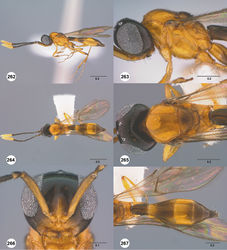Calliscelio torqueo
| Notice: | This page is derived from the original publication listed below, whose author(s) should always be credited. Further contributors may edit and improve the content of this page and, consequently, need to be credited as well (see page history). Any assessment of factual correctness requires a careful review of the original article as well as of subsequent contributions.
If you are uncertain whether your planned contribution is correct or not, we suggest that you use the associated discussion page instead of editing the page directly. This page should be cited as follows (rationale):
Citation formats to copy and paste
BibTeX: @article{Chen2017ZooKeys, RIS/ Endnote: TY - JOUR Wikipedia/ Citizendium: <ref name="Chen2017ZooKeys">{{Citation See also the citation download page at the journal. |
Ordo: Hymenoptera
Familia: Platygastridae
Genus: Calliscelio
Name
Calliscelio torqueo Chen & Johnson sp. n. – Wikispecies link – ZooBank link – Pensoft Profile
Description
Body length of female: 1.27–2.54 mm (n=20). Body length of male: 1.39–2.10 mm (n=16). Color of head: black throughout; brown throughout; orange throughout. Color of antennal clava (A7–A12): A7–A10 dark brown, A11 and A12 white to pale yellow. Shape of head: subglobose. Central keel of frons: absent. Setation of upper frons: with sparse, short setae. IOS/EH: IOS distinctly less than EH. Sculpture of ventrolateral frons: smooth to rugulose. Sculpture of frons below median ocellus: smooth. Sculpture of posterior vertex: smooth. Hyperoccipital carina: absent. Occipital carina medially: interrupted. Length of OOL: greater than 0.5× ocellar diameter. Sculpture of postgena behind outer orbit: smooth. Ocular setae: absent. A4 in female: distinctly longer than A3. A5 in female: shorter than A3, distinctly longer than wide. Shape of female A6: distinctly longer than wide. Form of male antennal flagellomeres: filiform, A11 approximately 4.0× longer than wide. Length of A5 tyloid in male: approximately 0.3× length of A5.
Color of mesosoma in female: orange throughout; black throughout; variably orange to pale brown. Color of mesosoma in male: orange throughout; variably orange to pale brown; black throughout. Sculpture of dorsal pronotal area: smooth. Sculpture of lateral pronotal area: smooth throughout. Sculpture of netrion: smooth. Notaulus: percurrent or nearly so. Sculpture of mesoscutum: coriaceous; smooth throughout. Shape of mesoscutellum: semiellipsoidal. Foveolae of scutoscutellar sulcus between notauli: smaller than those along margin of axilla. Sculpture of mesoscutellum: smooth with sparse fine punctures. Shape of metascutellum: posterior margin somewhat rounded, approximately 2.5× wider than long. Sculpture of metascutellum in female: smooth. Sculpture of metascutellum in male: smooth. Dorsal propodeum in female: not excavate medially, lateral propodeal carinae meeting anteromedially. Sculpture of dorsal propodeum in female: rugose. Sculpture of dorsal propodeum in male: rugose. Median keels on propodeum in female: absent. Mesopleural carina: absent. Sculpture of mesepisternum below mesopleural depression: smooth. Sculpture of ventral metapleural area: smooth. Color of legs: fore coxa pale yellow, otherwise variably yellow to pale brown; coxae pale yellow, otherwise orange. Sculpture of hind coxa: smooth.
Color of fore wing: hyaline. Rs+M: nebulose, weakly pigmented. Setae on R: long, erect, surpassing the margin of the wing. Length of R: approximately as long as r-rs. Length of R1: greater than 3.0× length of r-rs.
Color of metasoma in female: orange throughout; variably orange to pale brown. Color of metasoma in male: variably orange to pale brown. Horn on T1 in female: weakly developed. Sculpture of T1 horn dorsally: smooth. Sculpture of posterior margin of T1 in female: longitudinally striate throughout. Sculpture of T1 in male: longitudinally striate. Development of longitudinal striae on T2 in female: present on anterior margin of T2 medially, reaching posterior margin of T2 laterally. Sculpture of T3: smooth with longitudinal submedian striae. Shape of T6 in female: short, slightly longer than wide. Sculpture of S3: smooth.
Diagnosis
This species is most similar to Calliscelio glaber and Calliscelio paraglaber in the smooth head and metascutellum. It can be separated from Calliscelio glaber by its pigmented Rs+M and smooth small horn, from Calliscelio paraglaber by the absence of an occipital carina and T4 is distinctly longer than A3.
Etymology
The epithet is used as a noun in apposition derived from the Latin word for torch, in reference to female antennal club color.
Link to distribution map
[http://hol.osu.edu/map-full.html?id=384798]
Material examined
Holotype, female: ECUADOR: Pichincha Prov., 1540m, 00°00'23"N 78°40'36"W, Nanegalito, 27.X–31.X.1999, flight intercept trap, Z. H. Falin, OSUC 553598 (deposited in CNCI). Paratypes: (218 females, 88 males) COLOMBIA: 36 females, 16 males, OSUC 557420–557421, 557471–557472, 557476, 557478–557479, 557488, 557497, 557502, 557510, 557515, 557518, 557526, 557566, 557608, 557612, 557614–557616 (CNCI); OSUC 188727–188728, 188731, 193127, 193692, 202074–202075, 202079, 202081, 202084, 269216, 279912, 279916, 279919–279923, 279927, 280183, 280203, 280206, 377411, 377415–377416, 377418–377422, 377425–377426 (OSUC). COSTA RICA: 120 females, 38 males, OSUC 232067, 232070, 532466–532467, 532471–532473, 532475, 532477–532478, 532496, 532498, 532500–532501, 532504, 532511–532515, 532520, 532522, 532531, 532534, 532536, 532538, 532540–532542, 532544–532548, 532550, 532555, 532557, 532561–532562, 532564, 532566, 532571, 532579, 532584, 532595–532596, 532609, 532615, 532629, 532642, 532645, 532652, 532654–532655, 532659, 532661–532662, 532671, 532674, 532683, 532690, 532703–532705, 532707, 532727, 532729, 532731, 532733, 532736, 532742–532745, 532747–532748, 532754–532755, 532758–532764, 532768, 532770, 532772, 532776, 532779–532780, 532782, 532793–532795, 532797–532801, 532803–532822, 532826–532830, 532832, 532835–532840, 532918, 532920–532923, 532926–532927, 532931–532934, 534139–534141, 534236 (CNCI); OSUC 244741, 245170, 245172, 245174, 245237–245238, 246300, 246354–246355, 358624, 374055 (OSUC). ECUADOR: 14 females, 8 males, OSUC 534252, 553354, 553475, 553489, 553495, 553531–553536, 553539, 553574, 553597, 553599, 553617, 553667, 553672–553674, 553708–553709 (CNCI). PANAMA: 25 females, 13 males, OSUC 534086, 534088–534089, 534091, 534097, 534099, 553748–553749, 553752–553754, 553761–553763, 553765–553766, 553772, 553783, 553804–553806, 553815, 553819, 553823, 553836, 553843–553844, 553846, 553859, 553875–553876, 553928, 553933–553934, 553941–553943, 553951 (CNCI). VENEZUELA: 23 females, 13 males, OSUC 545830, 545871–545872, 545939–545940, 545955, 545957, 545991–545993, 557657, 557701–557707, 557712 (CNCI); OSUC 146810, 334525, 334545, 334547, 46271, 46275, 46569, 48153, 48213, 48232, 48327, 48481, 48756, 48784, 48789, 63915, 79762 (OSUC).
Original Description
- Chen, H; Masner, L; Johnson, N; 2017: New World species of the genus Calliscelio Ashmead (Hymenoptera, Platygastridae, Scelioninae) ZooKeys, (648): 1-136. doi
Images
|
